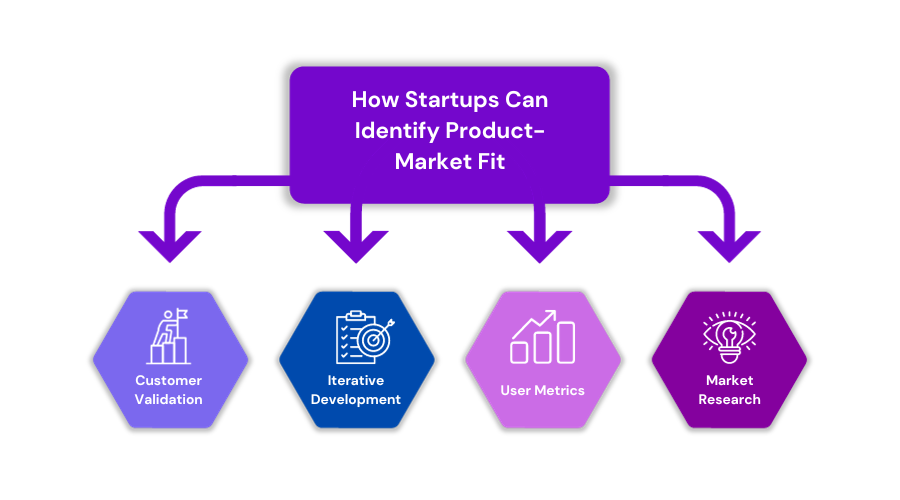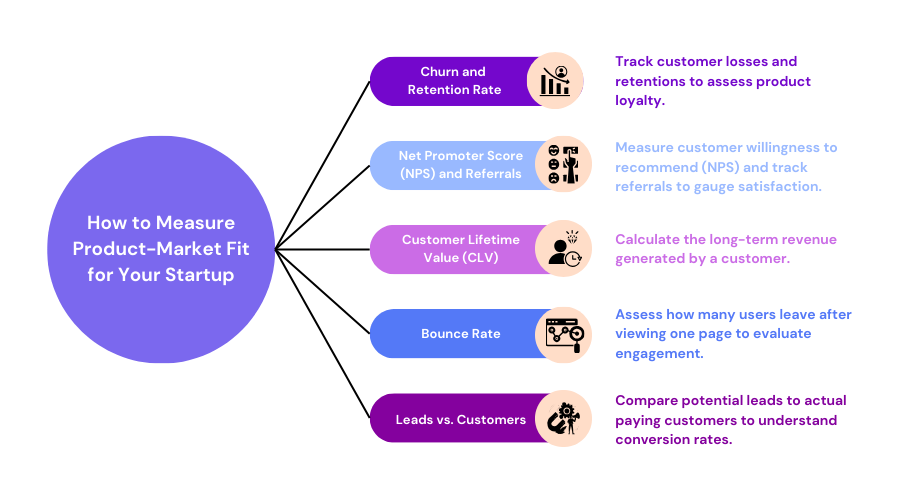How Can Start-ups Determine the Product Market Fit?

This article includes:
- What Is Product Market Fit?
- Top Indicators That Say That Your Startup Has Reached or Is Approaching the Product Market Fit
- Ways Startups Can Determine a Product Market Fit
- The Product Market Is a Two-way Street
- Product Market Fit=Focusing on the Market First
- Measuring the Product Market Fit for Your Startup
- Conclusion
To start a start-up is challenging, risky, requires patience, and everything in between. Even then, the research suggests that 90% of startups fail in their early stages of development.
There are many reasons a startup won’t see its fifth year, but the most important one is the product itself.
Many start-up founders will believe that they have found a product market fit. It is a problem because having that mindset is an illusion.
Before even discovering and deciding what to build, they hire employees, optimize their product, and increase the burn.
Everything goes for a toss when founders don’t recognize the gap that needs to be filled in the market or even determine the product goal.
Start-ups are generally considered high-risk investments with a low chance for success. So, how can start-ups determine the product market fit?
Start-ups often have difficulty determining whether they are close to product market fit. Knowing when you’re at the point of maximum customer acquisition or if you need to pivot your product can be challenging.
There are a few ways start-ups can determine the product market fit:
- Survey customers for feedback on their experience with your product
- Conduct interviews with customers about their pain points and needs
- Monitor customer retention rates and conversion rates
Bonus: We have previously discussed how you can achieve a product market fit. The steps to achieve a product market fit remains the same even for the start-up, except for a few things here and there.
However, there are a few things you need to consider when determining the product market fit for your startup. These factors will make your process of conducting a product market fit less challenging and more fulfilling. This article focuses on that and more, keeping your needs in mind.
Read on!
What Is Product Market Fit?
Product market fit is the term used to describe whether a product is meeting the needs of its customers. It is also known as “the holy grail” of start-ups.
To put it simply, you as a startup have achieved a product market fit when you are just trying to keep up with the product and cannot make any changes to it due to the overwhelming response from the users.
Startup founders will look at two things when pointing to the success of a product market fit: funding and the number of employees.
However, what you need to also look at is the efforts of founding teams trying their best to deal with the growing loyal, paying customers and keep them happy.
Fact: if you don’t find a product market fit, your startup will likely crash and burn. For example, the Investment research firm Gridstone had to bear the brunt of not finding the product market fit.
Top Indicators That Say That Your Startup Has Reached or Is Approaching the Product Market Fit
- People adore your product.
- Your CAC or customer acquisition cost is lower than the LVC(lifetime value of your customer).
- No one can replicate the business model you use.
- You measure what matters (Acquisition, retention, activation, referral, revenue).
- You know your customers well.
- You start feeling that demand is too much to handle.
Know that product-market fit is not a destination but a never-ending journey. Once you have completed a product market fit, you must put in the effort to maintain it.
Your product market fit will increase whenever you add a new product or feature to your product.
Don’t lose focus on the market. If the market changes, your product market fit will also likely change.
Ways Startups Can Determine a Product Market Fit
Build the Relationship With Your Customers
As a startup, your product will satisfy a small group of people in the market.
However, as your business grows, your understanding of the problem will also change; simultaneously, the customer profile is most likely to change.
To develop this understanding, you must talk to your customers repeatedly.
You can identify the problems, generate unique ideas, enhance your product, and in the process, build relationships too.
Customers and user interviews are one way to determine your product market fit. But how do you approach your customers?
It could be in person, on chat, or even over the phone.
We suggest you use a user survey template to discover or investigate your users’ thoughts about your product. And improvise on the questions as you go along in the conversation.
Here is an overview of survey templates offered by the number one agile product management tool, Chisel.
Chisel’s various tools and features with affordable pricing make it an ideal choice for start-ups.
Sign up for the free forever version here!
Pro tip: Use multiple-choice and open-ended questions to survey your customers.
Another way to understand your customers and target market needs is by collecting data through your internal team members. If you are a small team, then you will have to provide support yourself to your users.
If possible, hire a customer support staff in-house where customers can come and talk to you.
Your product team can also support you in this case. Your team can also collect and store customer needs and problems in one place.
If they receive some feature requests or specific complaints about the product functionality, take it as a sign and begin the conversation with your customer. This is the place where you can also learn about demand.
When you begin the conversation about the why and how of your product working or not working in the market, it will help you to come up with solutions.
This way, you can march toward product market fit and use the knowledge to plan your marketing strategy.
Not All Feedback Is Equal
This is a warning to all startups that not all feedback is created equal.
Having a context for product feedback is essential. The feedback you receive today may not be relevant but will be in the future.
It may be important six months down the road when you switch to a different market and have a change in your business goals.
The usage frequency of your product also makes a lot of difference to your feedback. For instance, you will consider the feedback from a user using your SaaS product daily versus someone who uses it irregularly.
The type of user, such as free, lead, or paying, will also affect their feedback value to your startup.

Pro tip: If you get feedback from mixed users, we suggest you record their feedback separately.
The Product Market Is a Two-way Street
As an early-stage startup, quick growth in the business (read money) is what you will reach for, and, in the journey, you will also get tempted to say yes to everything your customers request.
When your user asks for new features, you will build them to get more users on your list. However, short-term revenue is not an answer to building a sustainable business or your goal.
Know that you can’t take in requests from all your customers and please everyone.
If you get feedback as ‘I like, don’t like’ sorts, don’t act upon them when you know the customer is not a good fit for your product.
Before you consider feedback, see if it fits into your roadmap. Follow this up by prioritizing two things:
- On the basis of the impact, which is the people it will affect
- The effort your team will require to deliver the feature that is requested
You must be honest and upfront about your thoughts when the feedback doesn’t align well with your vision and plans.
It is better to say, “we do appreciate your feedback; however, we didn’t have this in mind.”
Finding Flexible Talent
Surviving in the digital and post-pandemic world is an arduous task for start-ups.
The first three years are the most vital for start-ups because, in these years, they are trying to find the product market fit with the available resources.
In all this chaos and finding the path, hiring the right talent for your company isn’t easy.
Let’s get to the root of this problem. Startups have little time to find the product market fit, which also requires excellent talent.
However, hiring a full-time employee (FTE) is a waste of time and money (it takes 36 days to hire an FTE). In addition to the fear of making the mistake of hiring the wrong talent and ending up with no talent and less money.
The best option all startups can adopt is to hire a flexible talent that will save both money and time and give you access to all the skills you require for your business.
We aren’t saying startups don’t require FTEs, but they can’t fulfill all the work criteria as they crop up during product market fit tasks.
Hiring a flexible talent, like a fractional CMO, is like getting independent contractors you can bring in as the demand arises and fit your time and commitment. When hiring someone, make sure to use contract templates and adjust to your conditions, because this will save a lot of time both for you and your contractor.
Product Market Fit Needs Agility
Startups are at a stage where many things can change simultaneously, such as core team members leaving, declining funds, market changes in demand, and so on.
In such a case, having an agile approach will set you on the right path to success.
Having a Flexible Talent Means Lower Cost Opinions Without Compromising on Agility and Speed
Switch around your traditional talent model to bring more agility to your business.
The roles and duties of the team will undoubtedly change during the early phases of a startup.
Remember, the initial stage of a startup and successfully finding a product market fit is not simple. Utilizing flexible talent and leadership; you can pivot as need be.
Product Market Fit=Focusing on the Market First
You will often notice that many people and founders will try and focus on getting solutions and ignoring problems. They hold onto solutions too tightly and lightly onto difficulties.
However, the real trick is to find the opportunity and grab it, including the problem, which is the MARKET.
Do you think you know how to solve problems persisting in the market with your “new idea”? Think again. Your perspective is usually wrong.
To get it right, follow the three steps of launching a product, talking to your customers, and iterating. This way, you will be able to pick up a product that will reach a product market fit.
Marc Andreessen points this out and writes, “the market pulls the product out of a startup.”
One of the best ways to determine the product market fit is to find customers with their hair on fire.
Michael Seibel gives the perfect example of this metaphor. In his conversation about ‘The real product-market fit,’ he said illustrating this metaphor can go a long way.
An example was if you had a friend standing next to you with their hair on fire. The only thing they would care about at that moment would be the fire. They wouldn’t care about anything else, such as hunger or if they were running late for a meeting.
Their priority will be to put the fire out.
In this case, if you give them a hose that is the perfect product, they will put the fire out and go their way.
On the other hand, if you gave them a brick, they would still take it and try to put the fire out by hitting it on their head.
The bottom line is that “you must find the problems that are so important for users that they will try out any solutions that come closer to their problems.”
We would suggest you build an MVP. To begin your journey in a market, you need an MVP that will get your initial customers on board, give you a chance to interact with them, and get feedback.
You can get feedback for all your possible half-baked products too.
This is what sets a startup apart from established companies. As a startup, you can move quickly, solve problems with good customer service, and your customers expect less from you.
To find a product market fit, finalize the market where the people have significant and real problems. After that, launch your product quickly and get the necessary feedback from your users.
Measuring the Product Market Fit for Your Startup
- Churn and retention rate
- Net promoter score (NPS) and the referrals
- Customer lifetime value (CLV)
- Bounce rate
- Leads vs. customers

Conclusion
To summarize the article, it is necessary as a startup to understand if you are bringing to market a product that will simply solve a problem or an innovative product that will relieve users of a huge burden.
To begin with, finding answers to the above questions will set you up on the right path to product development and determining the product market fit.
However, once you successfully determine the product market fit, firstly, Congratulations.
You took the efforts required to begin the task of finding the product market fit, and that’s a huge step toward success.
You are further ahead than your other startup counterparts.
Now you can start to optimize your core product, hire specialists to increase work efficiency, and make investments strategically.
